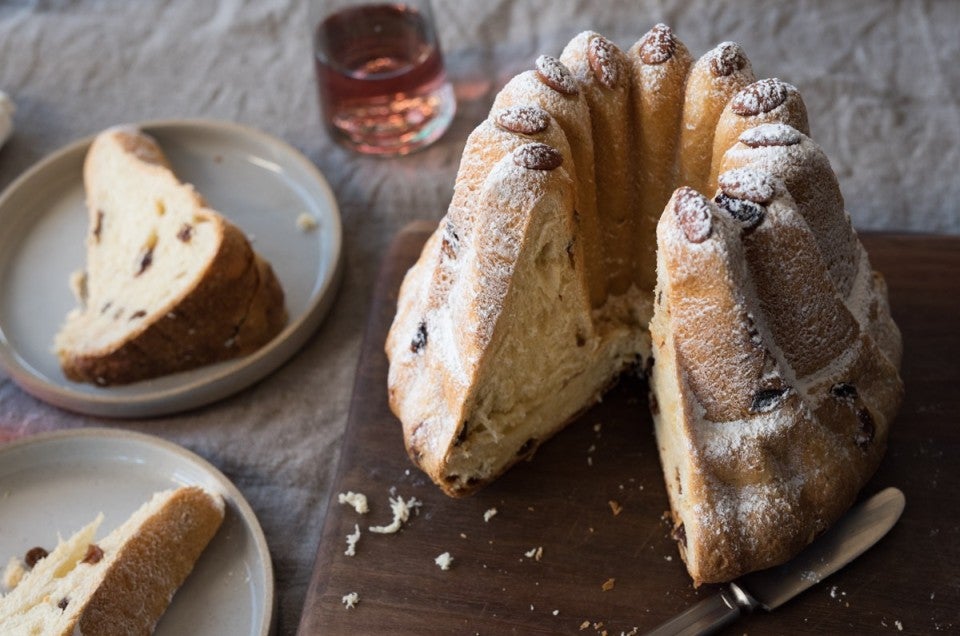


With this post we welcome Maurizio Leo as a regular contributor to Flourish. Maurizio's award-winning blog, The Perfect Loaf, is a beautifully photographed ode to baking naturally leavened sourdough.
My family’s end-of-the-year holiday meals are always punctuated with a towering, golden panettone. The eggy, buttery cake is the perfect finale to a large gathering, and almost always necessitates a glass of cold Moscato or other sweet wine for the full effect.
And while panettone is the quintessential Italian holiday dessert, each culture seems to have a cake that’s similar in some way, perhaps not quite as rich and eggy, but similar nonetheless. With the holidays here, and my search for cakes to bake at high intensity, I'm taken by the striking form of an Alsatian enriched cake called a kugelhopf.
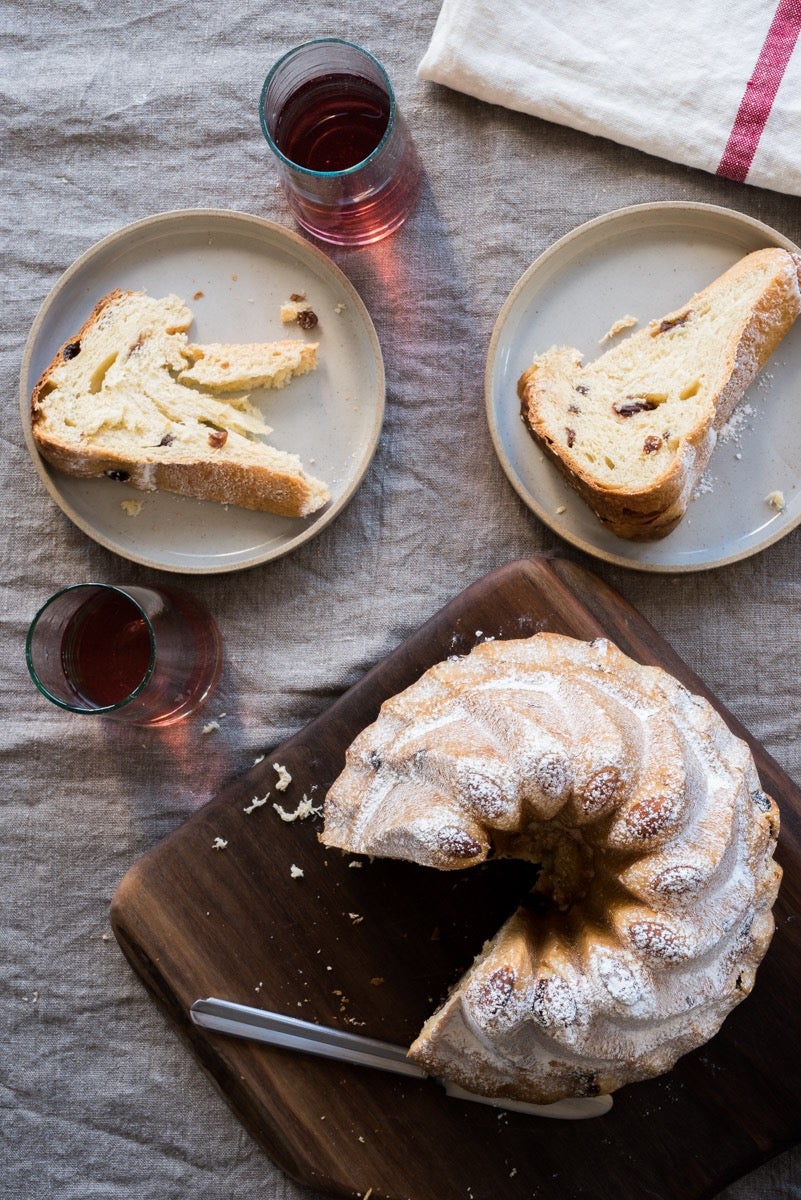
The birth of brioche-style kugelhopf is not exactly clear: French, Swiss, Austrian, and German cultures all have their spin on this leavened cake and, as with anything stretching back in history, each makes their version with a certain vigor. Most eat it for breakfast. And because it’s not quite as rich as panettone, I’d say it’s just about perfect in that setting — or perhaps anytime one is enjoying a cup of coffee and a quick break.
My goal for this cake is to take my typical sourdough approach to leavening and produce a soft, fruit-studded, brioche-style kugelhopf rich enough to help bolster you on a cold, holiday morning.
The liquor-macerated raisins and sour cherries will help rein in the potential cloying nature of a cake laden with fruit; while the subtle aroma and flavor of orange blossom water will add a hint of bitter orange peel.
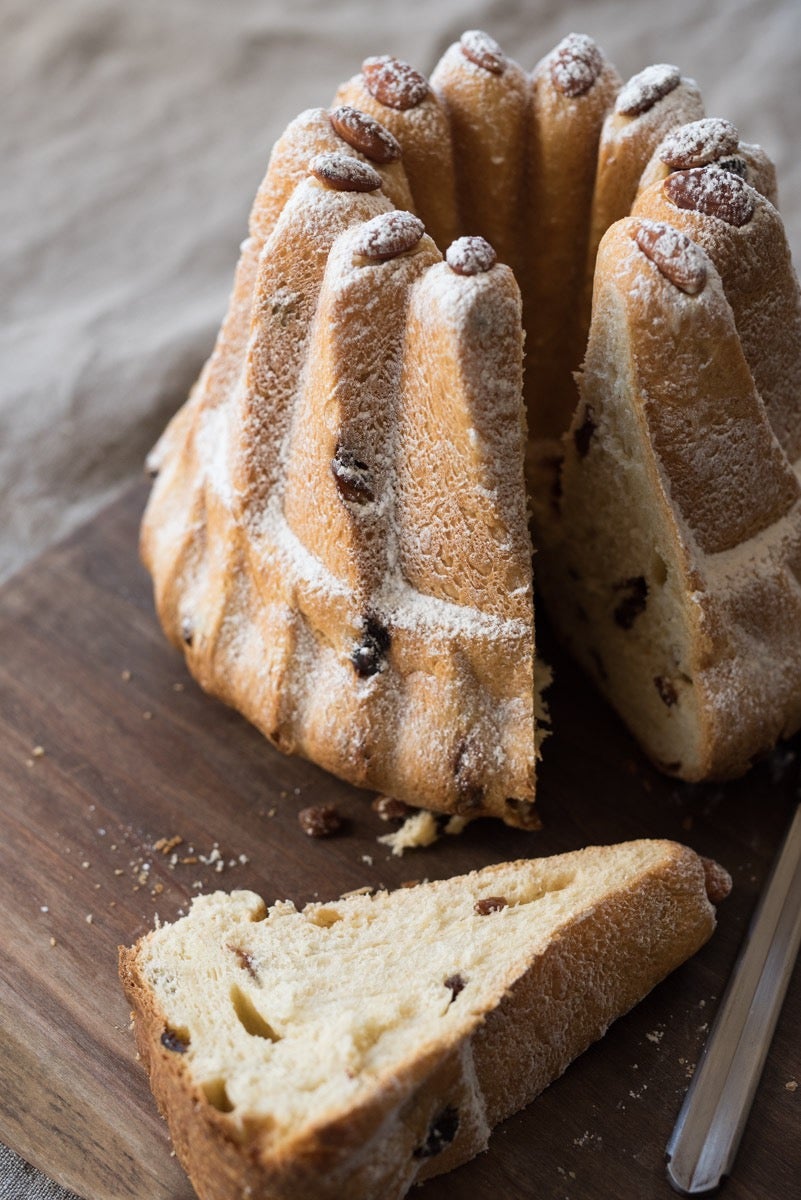
As is the tradition, a single almond is placed at each “peak” of the cake with the entire thing dusted liberally with confectioners' sugar — somehow evoking the feeling of tall mountains in Alsace lightly dusted in fresh snowfall.
I baked several iterations of this recipe until landing on a balanced combination of flour, eggs, fruit, sugar, and butter. Early trials used only a couple eggs and about three-fourths of the butter. In later versions, I moved up to the full quantity of butter called for and a total of four eggs, finally finding the soft texture and level of richness I was after.
As a side note, it’s incredible how much hydration a single egg will add to the dough. If you’re tempted to increase/decrease the eggs called for, adjust the flour as necessary (see more in the hydration notes below).
Below you’ll find some notes on the various ingredients in this recipe, and a few interesting things I discovered while developing it. But first, if you don’t have a traditional 10-cup kugelhopf mold, most 10- to 12-cup Bundt pans will work just as well with this recipe. In either case, be sure to liberally butter the mold’s interior, especially those with very intricate designs, to ensure the cake can be removed cleanly.
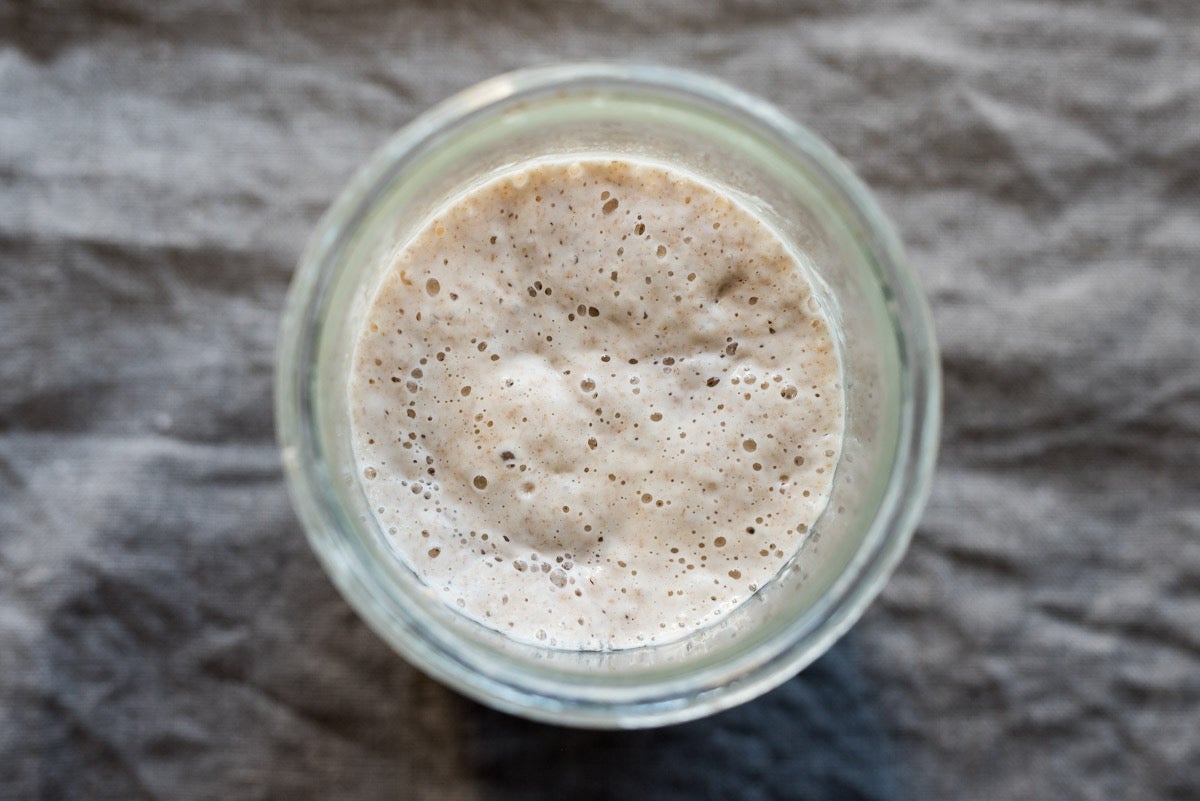
My sourdough starter is fed twice daily with 50% whole wheat, 50% unbleached all-purpose flour, and 100% water (100% hydration). Because it’s fed often, and with enough fresh flour and water to tide it over until my next feeding, it’s kept at a very mild state. This recipe calls for a “mature sourdough starter,” which means using it when it’s most active — before it begins to turn overly acidic and take on an increasingly sour smell.
If your starter is maintained with just white flour, just rye flour, or any other combination of flours things will still work just fine (with perhaps a small amount of these flavors peeking through in the end).
King Arthur Unbleached Bread Flour works very well in this recipe due in part to its higher protein percentage, providing sufficient strength and elasticity to support the butter added. Additionally, because the flour has malted barley flour included, it adds a wonderful golden-brown color to the crust when baked.
When baking pastry, I prefer European-style butter for its higher butterfat percentage, lending a slightly more rich taste and deep yellow color to the end product.
It’s important to have the butter at the correct temperature. Leave it on the counter for about 25 to 30 minutes before adding it to the dough. I find taking it out 10 minutes before mixing is just right (because there’s approximately 20 minutes of mix and rest time before needing the butter).
When used, the butter should still be cold to the touch but easily dented and bent by a finger. If it cracks it’s too cold; and if there's a puddle of butter on the bottom of the bowl where it’s resting, it’s too warm.
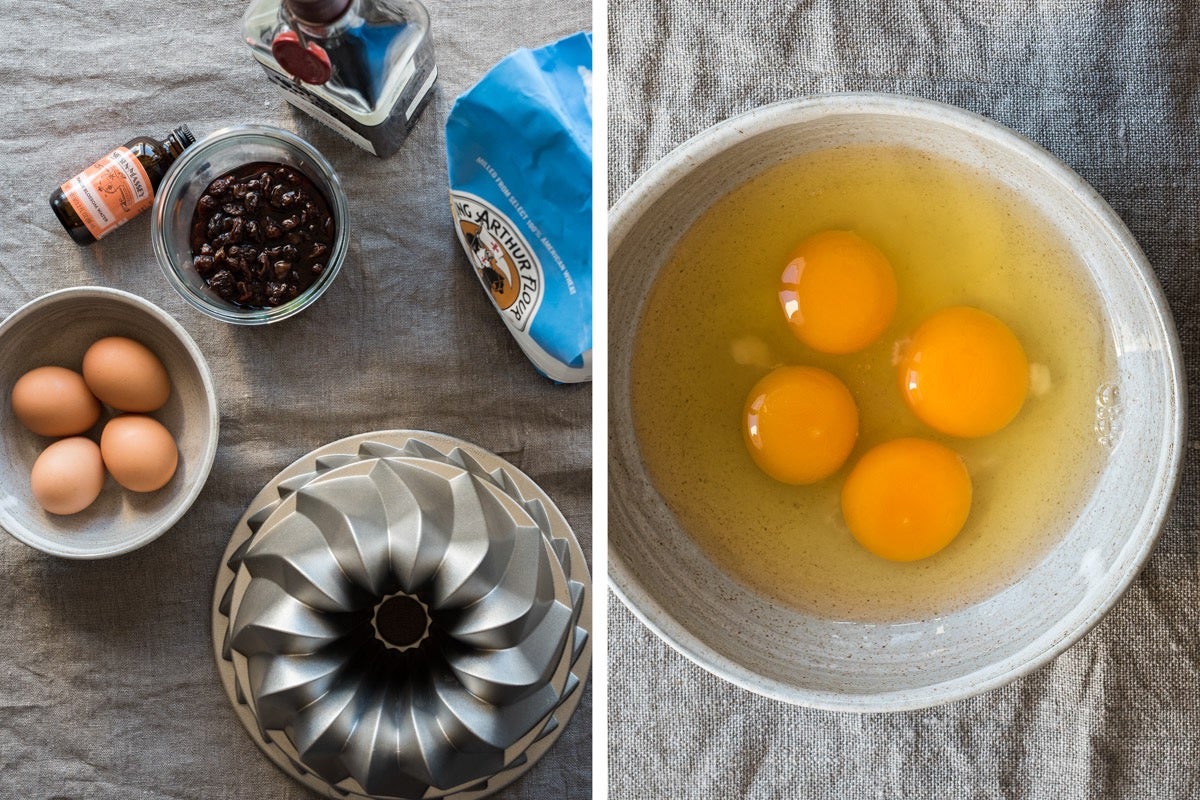
This dough leans toward the wet side of things, but it will still be strong enough to handle. The slightly high hydration helps the dough ooze in and fill the nooks and crannies of any chosen Bundt pan, and especially a kugelhopf mold.
As with any enriched dough, the amount of liquid added to the flour sometimes needs a little adjustment dependent on the flour used, and even the weather on the day of baking. That said, use the photos below as a guidepost for how the dough should look and feel, and adjust as necessary: add more flour, a little at a time, if the dough just won’t come together during mixing.
Note: the percentages listed for some of the ingredients below are for those of you who use baker's percentage (baker's math) in measuring.
1/2 cup (3 ounces, 85g) sweetened tart cherries
1/2 cup (3 ounces, 85g) Thompson raisins
1 cup (8 ounces, 227g) Kirsch liqueur, or other cherry-flavored liqueur
13 tablespoons (6 1/2 ounces, 185g) European-style butter
4 cups + 2 tablespoons (17 3/4 ounces, 501g) King Arthur Unbleached Bread Flour (100%)
2 1/4 teaspoons (generous 10g) salt (2.37%)
3/4 cup + 2 tablespoons (6 3/4 ounces, 194g) mature (fed) sourdough starter,* stirred down (45.86%)
1/2 cup + 1 tablespoon (4 1/2 ounces, 130g) cold whole milk (30.77%)
4 large (185g, shelled) eggs, cold (43.79%)
1/4 cup (1 3/4 ounces, 50g) granulated sugar
1 tablespoon (1/2 ounce, 14g) orange blossom water, optional
confectioners’ sugar, for dusting
*Note: Since this dough has no added yeast, your starter will be doing all of the rising work. Make sure your starter is very vigorous and active, feeding it several times before using, if necessary.
The night before baking the kugelhopf, soak the cherries and raisins in the kirsch. Use a jar that’s slender enough to ensure the fruit is completely submerged in the liquor.
Build up the 100% hydration sourdough starter so there's enough in the morning for the dough mix. My typical feeding is 100g flour, 100g water, and 20g mature starter — this will ensure enough sourdough starter to cover this recipe, plus a little left over to keep the culture going.
First, measure out the called-for butter and cut it into 1-tablespoon chunks. Let it sit on the counter at room temperature for 30 minutes, until called for at the end of mixing.
Drain the cherries and raisins, reserving leftover Kirsch for another use, if desired.
In the bowl of a stand mixer, stir together the flour and salt. In a separate bowl, whisk together the mature liquid sourdough starter, cold milk, cold eggs, and sugar.
Set the stand mixer fitted with a dough hook to stir (slowest speed), and slowly add the liquid mixture to the flour mixture over the course of 2 to 3 minutes, until incorporated.
Let the dough rest for 10 minutes. While the dough is resting, combine the drained fruit with the orange blossom water in a separate bowl.
Turn the stand mixer to medium speed and mix the dough for 8 to 9 minutes, scraping down the sides with a bowl scraper when necessary, until it starts to ball around the dough hook (it will still stick to the bottom and slightly to the sides of the bowl). The dough should look smooth with no clumps, and start to display signs of elasticity.
With the mixer set to medium-low speed, add the butter 1 tablespoon at a time over the course of 5 to 6 minutes. Try to add the room-temperature butter right where the dough hook meets the dough, turning off the mixer if necessary, as it incorporates more efficiently this way.
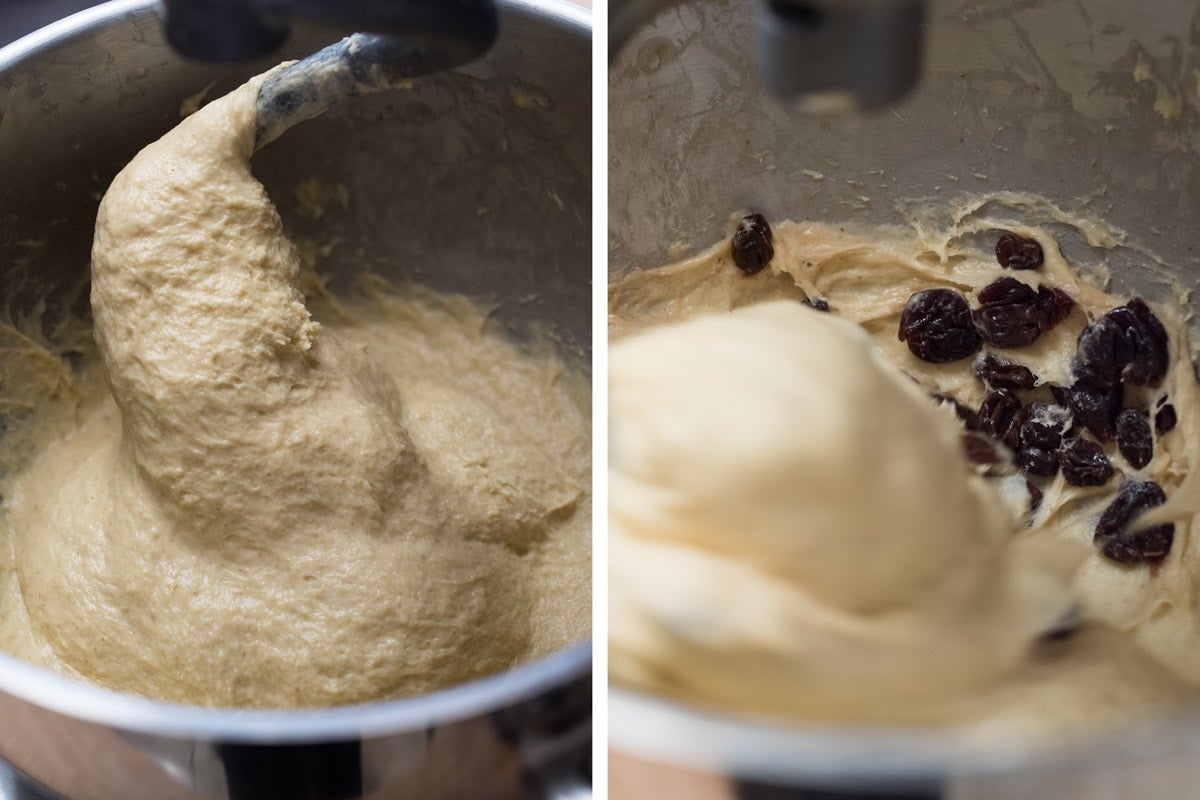
After adding the butter the dough should look elastic and shiny, with no lumps remaining. Set the mixer to stir and add the fruit a little at a time, until incorporated and well distributed.
Transfer the dough from the mixer to a bowl and cover with plastic wrap for its bulk fermentation (first rise).
To build additional strength in the dough, perform four sets of stretches and folds during the 2 1/2 hours of bulk fermentation at around 75ºF ambient temperature.
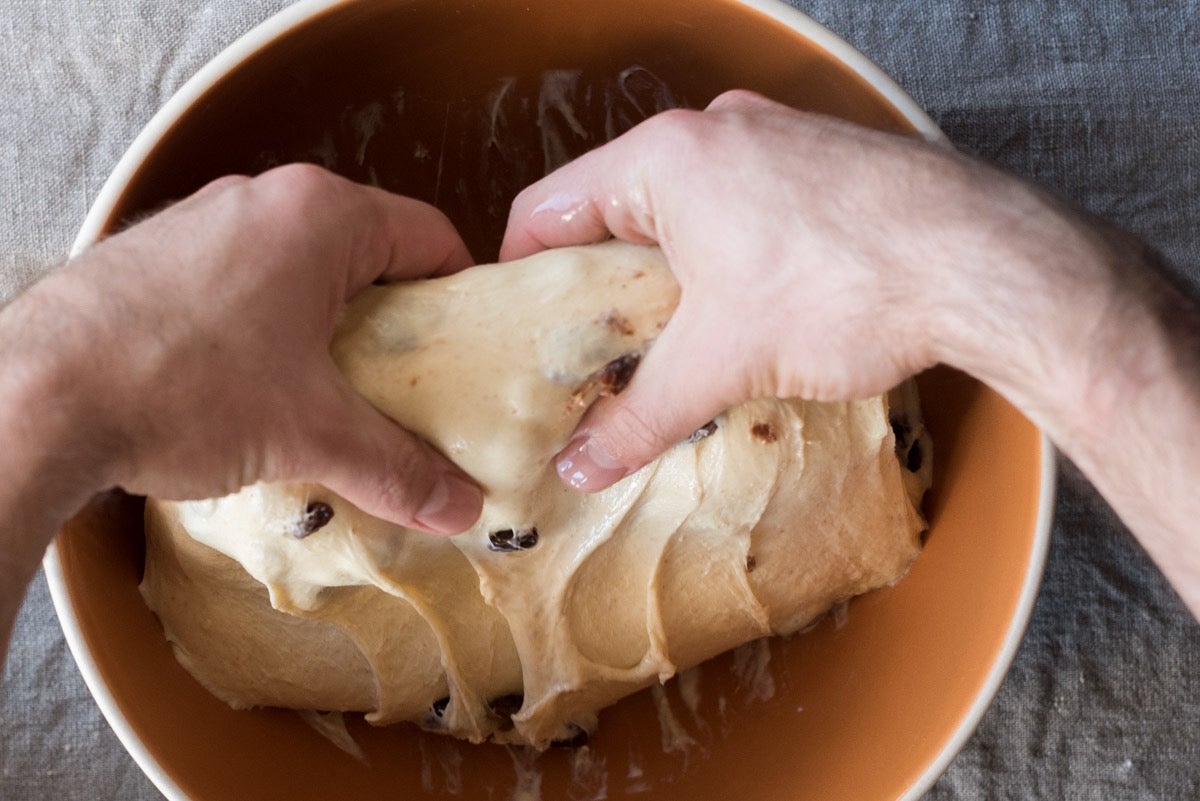
After the first 30 minutes of rise, use your two slightly wet hands to grab the dough at the top of the bowl, stretching it up and folding it over to the bottom of the bowl. Rotate the bowl 180º and perform the same action. Then, rotate the bowl 90º and repeat, stretching the dough at the top of the bowl and folding it to the bottom, and vice versa, bottom to top.
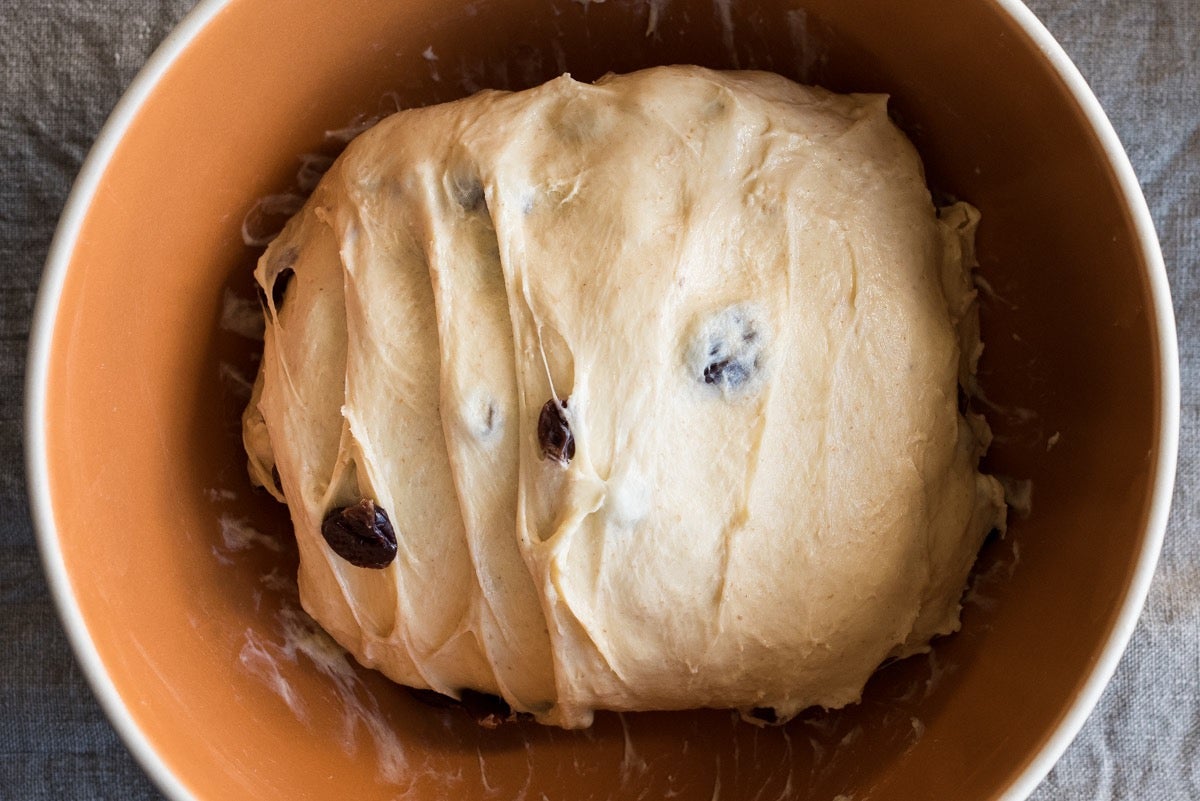
The dough should now be folded into a tight little package in the center of the bowl. Cover again with plastic wrap.
Let the dough rest for 30 minutes. Repeat the above folds at 30-minute intervals for a total of four sets. After the last set, let the dough rest for 30 minutes.
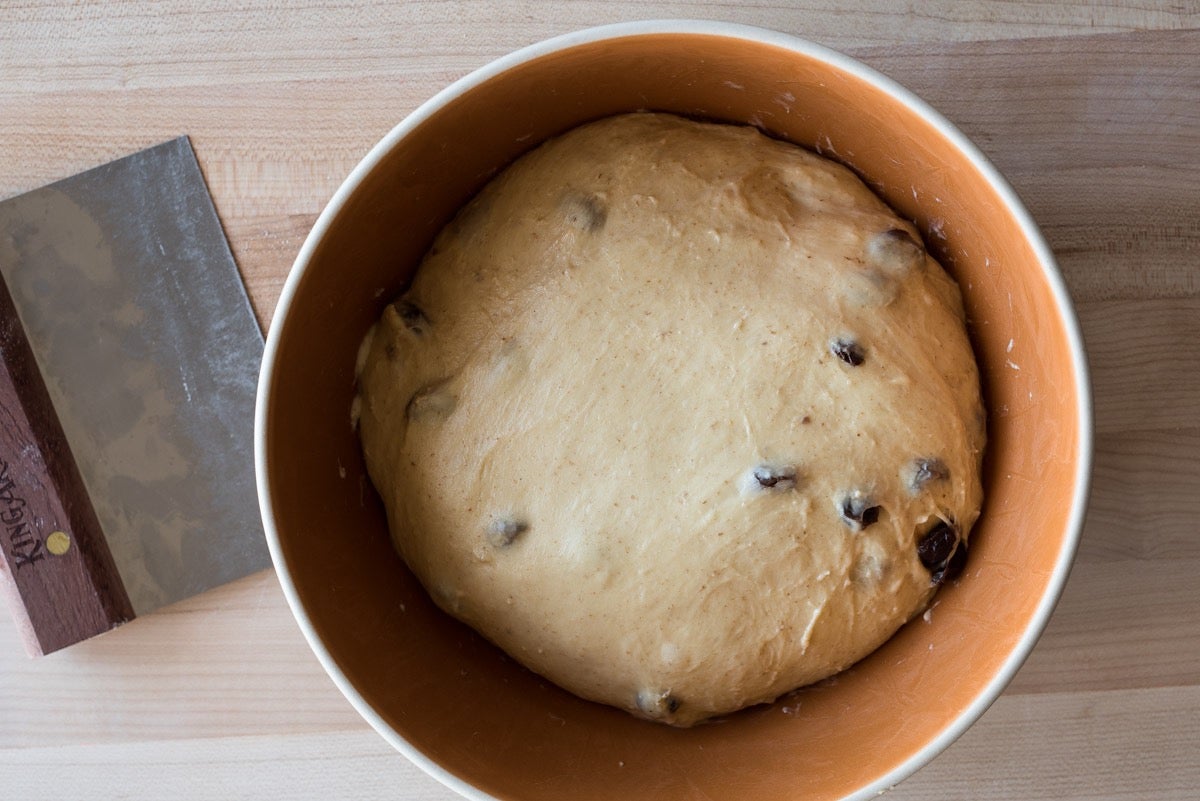
At the end of its rise, the dough will look similar to the photo above: stronger, smoother, and significantly risen, displaying a slight jiggle when shaken.
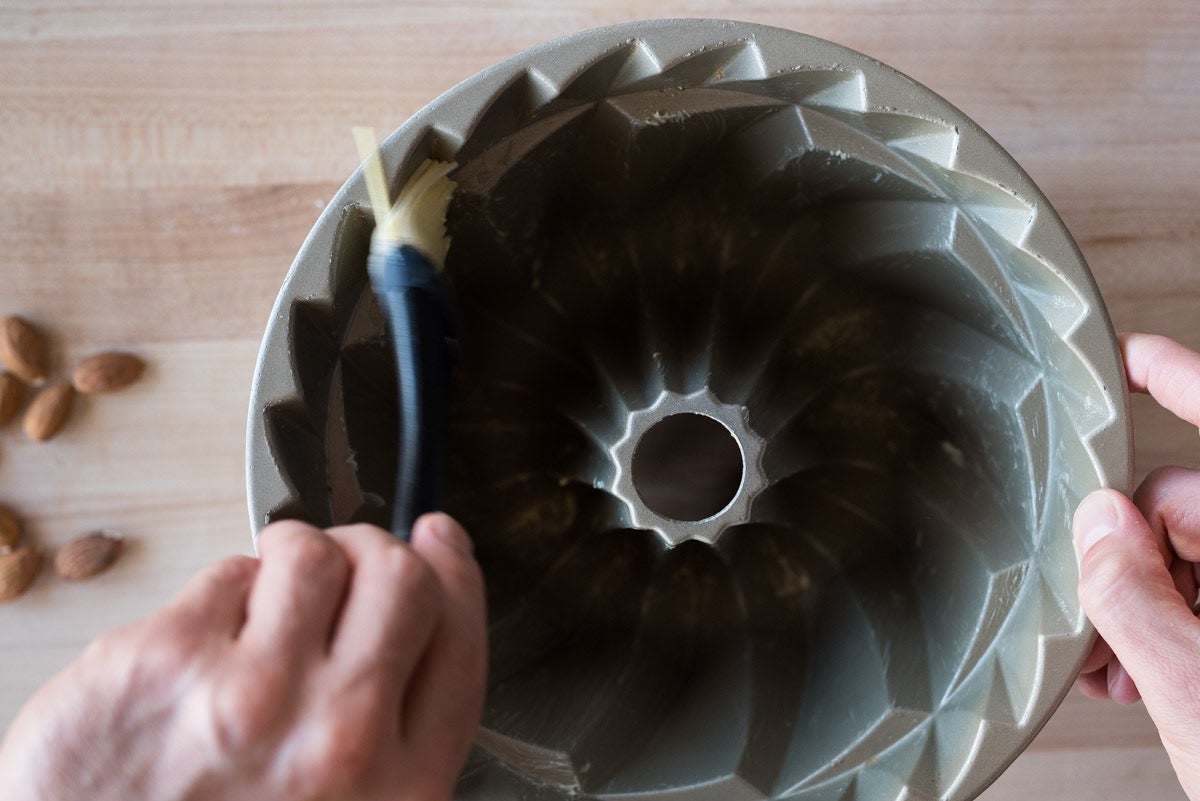
Melt 1/2 tablespoon butter and use a pastry brush to coat the entire interior of a 10-cup kugelhopf mold or 10- to 12-cup Bundt pan. Place a single almond at the very bottom of the mold in each “peak.”
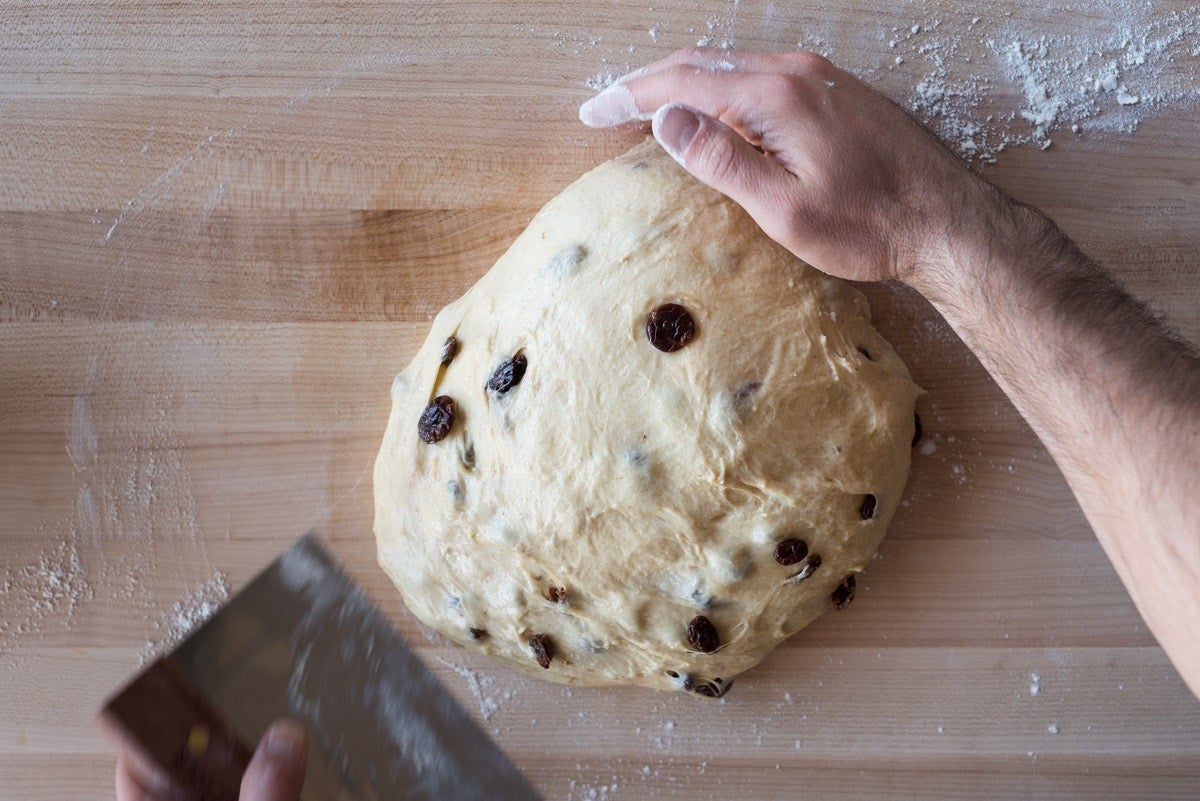
Lightly flour the counter and, using a bench knife, dump the dough out of the bulk container onto the counter. With the bench knife and lightly floured hands, round the dough several times into a tight circle (boule) shape. The dough will be sticky; rely on the knife and your floured hands to build a little more strength into the dough, so it’s a tight round.
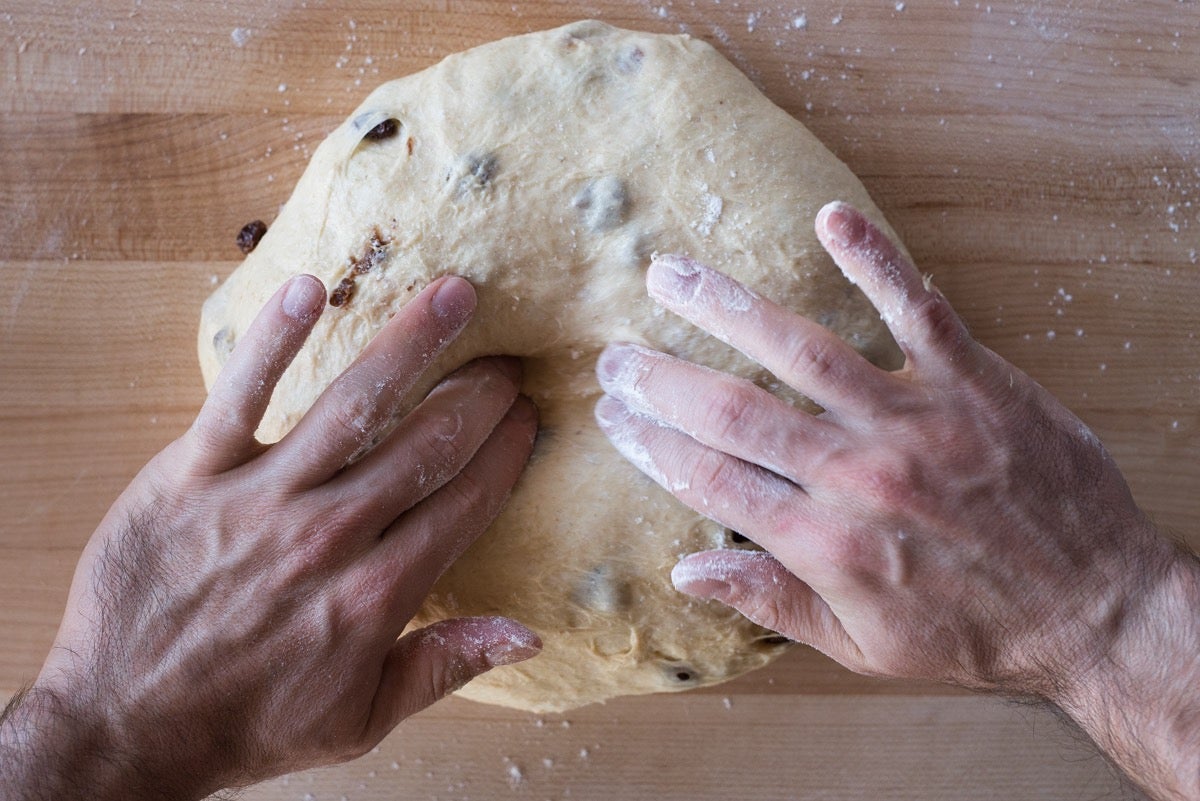
Using your fingers, punch a hole directly in the center of the dough and stretch the hole wide enough to allow the center of the mold to push through.
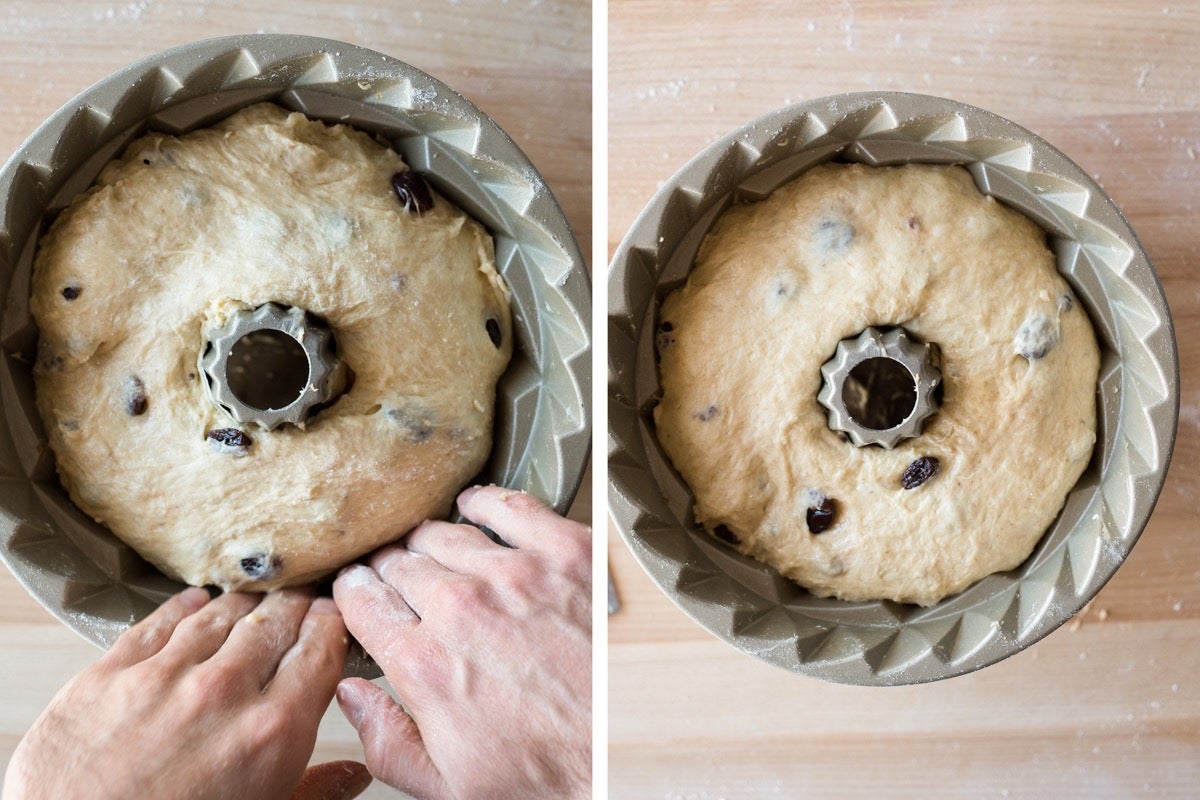
Using the bench knife and your hand, place the dough into the buttered mold. Gently pat the dough so it’s even around the entire mold. Cover the mold loosely with plastic wrap; I like to place a small rounded dish in the center of the mold to keep the plastic up off the dough as it rises.
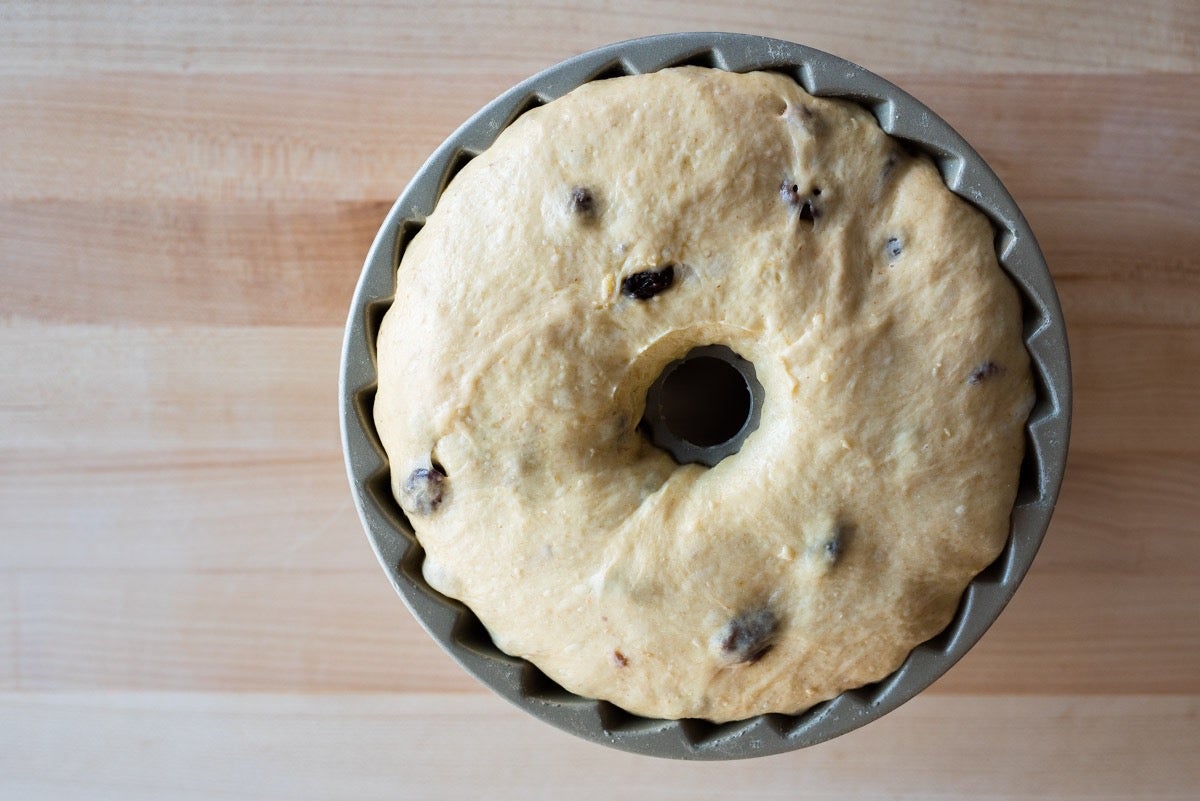
Let the dough rise for 3 to 3 1/2 hours at 75ºF, until it reaches the rim of the mold.
Toward the end of fermentation, place a rack in the bottom third of the oven and preheat the oven to 400ºF.
Bake the kugelhopf for 30 minutes, rotating the mold halfway through. Turn the oven down to 375ºF and bake for an additional 10 to 15 minutes, until the cake tests done.
Because a large portion of the dough isn't visible, it can be hard to tell when the cake is done; bake until the visible part of the dough is a deep, golden brown and the cake's internal temperature is around 200ºF to 205ºF. Keep an eye on the cake for the last 10 minutes, tenting it with foil or adjusting the bake time as necessary.
Remove the cake from the oven and cool it on a rack for 10 minutes. Then turn the cake out of the mold onto the rack and allow it to cool completely, 3 to 4 hours.
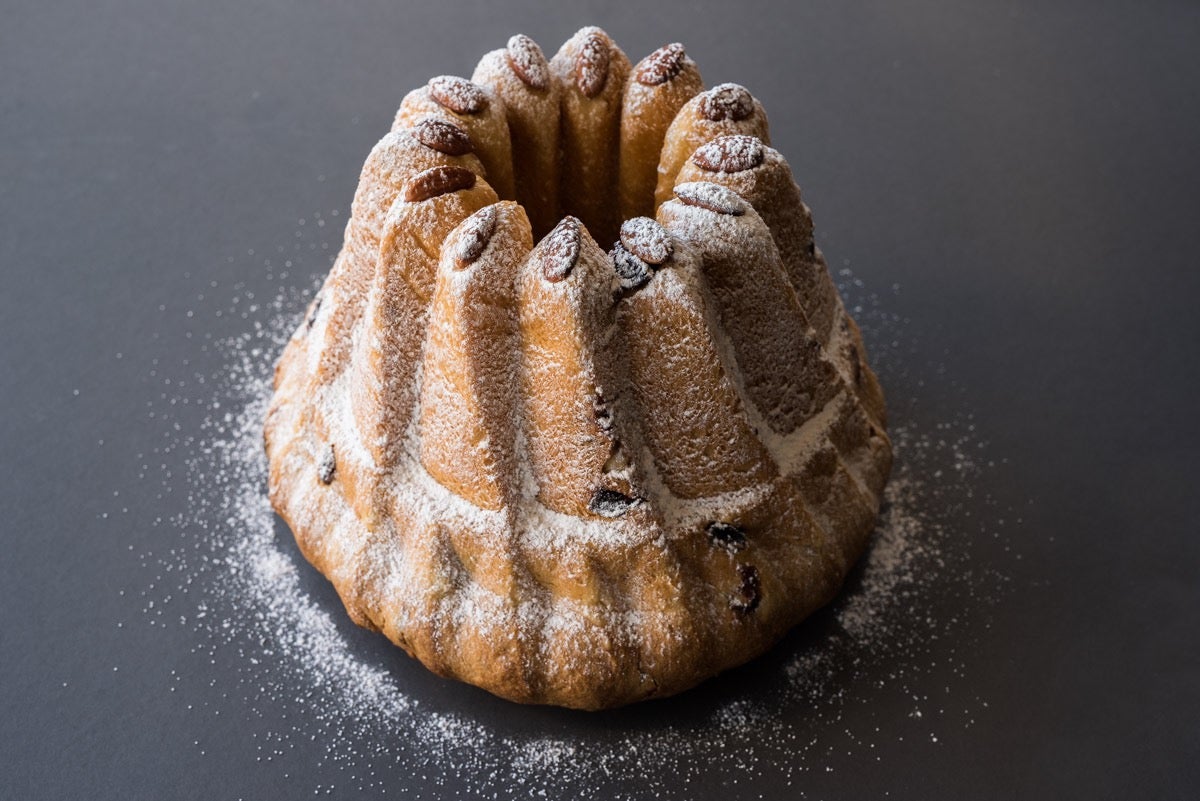
Dust the cake with confectioners' sugar and serve.
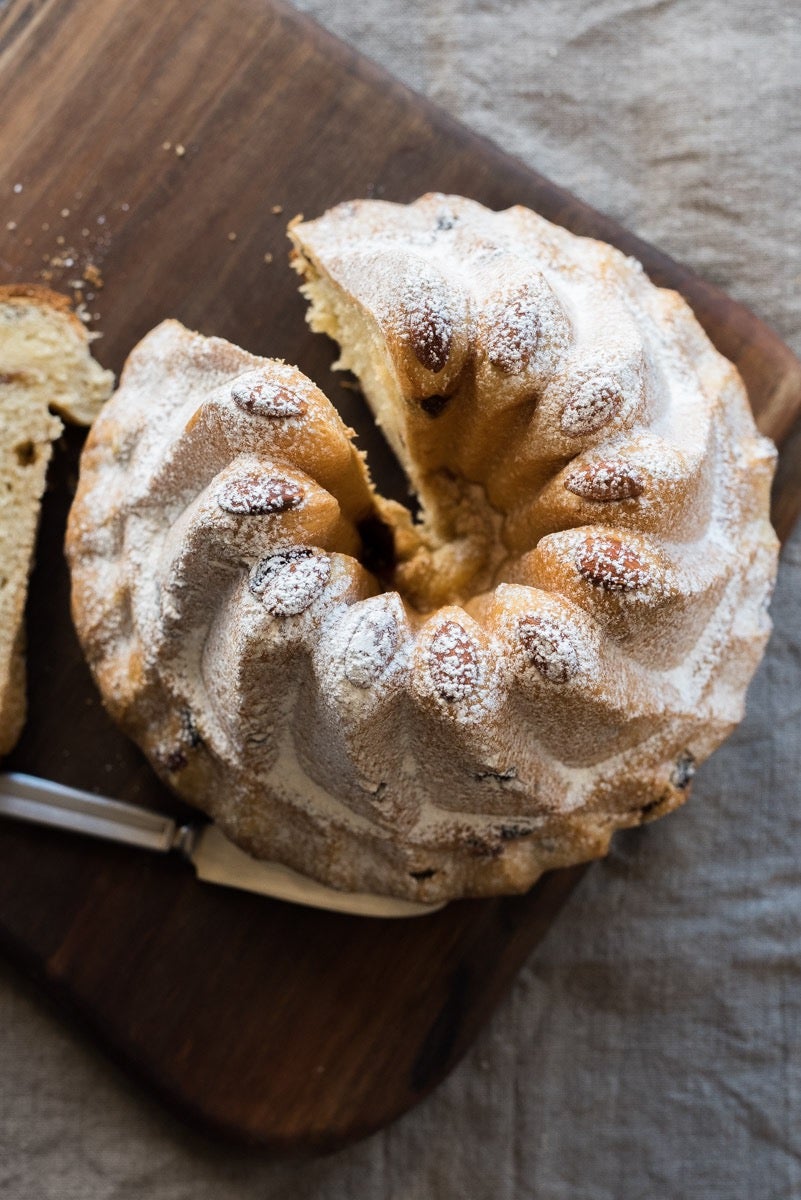
I find this cake tastes even better the next day. Enjoy!
Please read, bake, and review this recipe for Naturally Leavened Brioche-Style Kugelhopf.